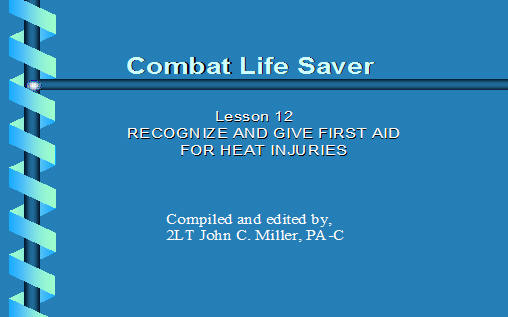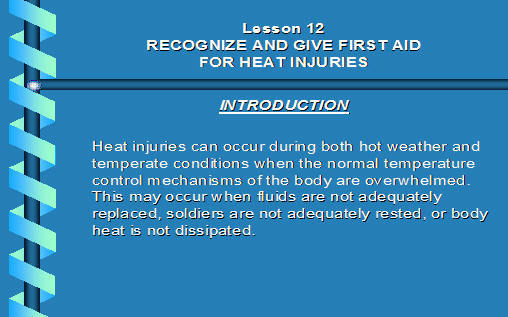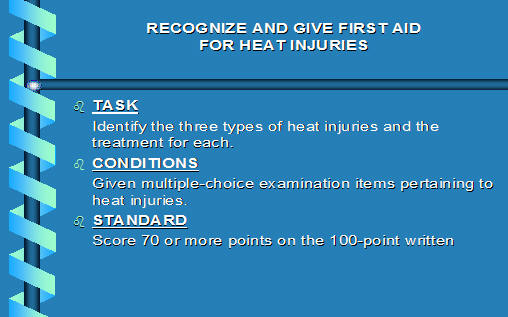RECOGNIZE AND GIVE FIRST AID FOR HEAT INJURIES
Click here to download the presentation.



Lesson 12
RECOGNIZE AND GIVE FIRST AID
FOR HEAT INJURIES
INTRODUCTION
Heat injuries can occur during both hot weather and temperate conditions when the normal temperature control mechanisms of the body are overwhelmed. This may occur when fluids are not adequately replaced, soldiers are not adequately rested, or body heat is not dissipated.
RECOGNIZE AND GIVE FIRST AID
FOR HEAT INJURIES
TASK
Identify the three types of heat injuries and the treatment for each.
CONDITIONS
Given multiple-choice examination items pertaining to heat injuries.
STANDARD
Score 70 or more points on the 100-point written
IDENTIFY SIGNS AND SYMPTOMS OF HEAT
CRAMPS
Grasping or massaging a limb (arm or leg) or bending over in an effort to relieve the pain of an abdominal cramp.
Skin wet with perspiration.
Unusual thirst.
TREAT HEAT CRAMPS
Move the casualty to a cool, shaded area to rest. Use poles, ponchos, blankets, or other available materials to improvise a shade, if needed.
Loosen the casualty’s clothing around his neck and waist and loosen his boots.
Do not loosen the casualty’s clothing if you are in a chemical environment.
Have the casualty slowly drink one quart (one canteen) of cool water.
Seek medical help or evacuate the casualty if the cramps continue.
IDENTIFY SIGNS AND SYMPTOMS OF HEAT
EXHAUSTION
Most Common Signs and Symptoms of Heat Exhaustion
Profuse sweating with pale, cool skin.
Weakness or faintness.
Dizziness.
Headache.
Loss of appetite.
IDENTIFY SIGNS AND SYMPTOMS OF HEAT
EXHAUSTION
Other Signs and Symptoms of Heat Exhaustion
Heat cramps.
Nausea (with or without vomiting).
Chills (“gooseflesh”).
Rapid breathing.
Urge to defecate.
Tingling in hands or feet.
Mental confusion.
TREAT HEAT EXHAUSTION
Move the casualty to a cool shaded area to rest. Improvise a shade, if necessary.
Position the casualty to lie on his back with his legs elevated (normal shock position).
Remove the casualty’s clothing around his neck and waist and loosen his boots.
Pour water over the casualty and fan him to cool his body faster.
Do not loosen or remove clothing or pour water over the casualty if you are in a chemical environment.
TREAT HEAT EXHAUSTION
Have the casualty slowly drink one quart (one canteen) of cool water.
If the casualty cannot drink the water because of nausea or if he vomits, the combat lifesaver will insert an intravenous line and evacuate.
If the casualty recovers, have him perform only light duties for the remainder of the day if the mission permits.
IDENTIFY SIGNS AND SYMPTOMS OF HEAT
STROKE
Lack of or severe decrease in normal perspiration. (Decrease in perspiration is caused by the collapse of the body’s cooling mechanisms, including perspiration.)
A soldier who is not perspiring or perspiring very little while other soldiers performing the same work are perspiring freely is in danger of heat stroke. Take emergency measures immediately.
IDENTIFY SIGNS AND SYMPTOMS OF HEAT
STROKE
Skin that is hot, dry, and red.
Headache.
Weakness.
Dizziness.
Mental confusion.
Nausea or stomach pains.
Seizures.
Weak and rapid pulse and respiration.
Sudden loss of consciousness.
TREAT HEAT STROKE
Heat stroke is a medical emergency. In heat stroke, the body’s internal (core) temperature increases to dangerous levels. If the casualty’s body temperature is not lowered quickly, brain injury or death may result.
Send someone to get medical help while you work with the casualty.
Move the casualty to a cool, shaded area or improvise a shade.
Loosen or remove the casualty’s outer garments.
TREAT HEAT STROKE
Position the casualty on his back with his feet elevated while pouring cool water over the casualty, fanning him vigorously, and massaging his arms and legs with cool water. Mist is more effective than pouring water.
Do not loosen or remove clothing, pour water over the casualty, or massage his limbs if you are in a chemical environment.
Have the casualty slowly drink one quart of cool water if he is able. If unable to drink, insert an intravenous line.
TREAT HEAT STROKE
Evacuate the casualty as soon as possible.
Do not delay evacuation in order to start cooling measures. Perform cooling measures en route to the medical treatment facility.
Monitor the casualty’s breathing. Administer mouth-to-mouth resuscitation if needed.
RECOGNIZE AND GIVE FIRST AID
FOR HEAT INJURIES
CLOSING
Any heat injury casualty should be examined by medical personnel even if he appears to recover fully. Heat injuries can be avoided by adequate rest, proper clothing, and adequate fluids. This lesson is tested on the written examination.
Questions